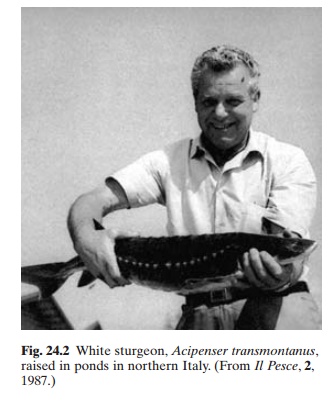Chapter: Aquaculture Principles and Practices: Other Finfishes
Other Finfishes
Other Finfishes
In the preceding an attempt has been made to summarize the culture
practices relating to the major groups of finfish which contribute
substantially to aquaculture technologies and production. As mentioned earlier,
there are several other species which are cultured on a small scale in limited
areas or which have shown potential to become important aquaculture species in
the near future. Among the first category are the murrels (or snake-heads) and
gouramis of Asia, the groupers and rabbitfish of the Indo-Pacific and Middle
East regions and the turbot of Western Europe. This section deals briefly with
the culture practices of the above-mentioned groups.
Besides these, the South-American species of the genus Colossoma and the Florida pompano (Trachinotus carolinus) have received
considerable attention from aquaculturists, although commercial-scale production
has yet to be developed. The cod (Gadus
morhua) and the halibut (Hippoglossus
hippoglossus) are being intensively investigated in North European
countries, especially Norway. Though the main focus of attention is to
mass-produce young cod for enhancing natural populations, small-scale rearing
to market size in captivity has been attempted with encouraging results. Though
much more experimental work is required, it has been possible to propagate cod
and halibut artificially and rear the larvae to juvenile stages.
Some of the pioneering work on marine fish cultivation was focused on
the flat fish plaice (Pleuronectes
platessa) and sole (Solea solea).
Techniques of controlled reproduction, larval rearing and grow-out have been
tried with considerable success. However, commercial farming of these species
is at present considered not economically attractive because of the low market
value of plaice and the slow growth rate and problems of feeding sole.
There are some attempts at the breeding and culture of flounders –
southern flounder (Paralichthys
lethostigma), summer flounder (Paralichthys
dentatus) and olive flounder, (Paralichthys
olivaceus) in the East, and winter flounder (Pseudopleuronectes americanus) in the USA (Jeon et al., 1992; Howell and Litvak, 2000;
Daniels and Nardi, 2001).
Two groups of species that are presently cultured and of importance in
restricted areas are the pufferfish (Fugu
rubripes and F. vermicularis) and
the sturgeons. The pufferfish are aspeciality seafood only in Japan, Korea and
China and are of limited interest elsewhere. Artificial propagation and larval
rearing of pufferfish are well advanced and marketsized (800 g) fish are
produced in ponds and cages, fed on trash fish.
The sturgeons are of special importance as food fish and as a source of
the high-valued caviar. Economically important species of stur-geons have been
reproduced in hatcheries and young ones are released every year to enhance
natural populations that have been greatly reduced by overfishing and
environmental changes. However, small-scale culture of some species is
undertaken in the former USSR and other East European countries. The sterlet (Acipenser ruthenus) is considered a
suitable fish for polyculture in carp ponds with adequate water flow and
aeration. The sterlet is benthophagous, feeding on chironomids and
oligochaetes, but can be grown on artificial feeds containing about 40 per cent
protein. The hybrids of beluga (Huso

While pond culture is
carried out in the southwestern part of the former USSR, pen culture is
practised in the bays of the Baltic sea and parts of the Azov sea. Since
growing seasons are restricted to five to eight months, the fingerlings usually
take two growing seasons to reach the market size of
800 g in the south, and three seasons in the colder northern waters.
Stocking rates are usually 7000–8000 per ha in ponds and 20–40 per m2 in pens, with average yields of
10–25/kg per m2 in pens and 980 kg/ha in ponds.
Experimental and pilot scale sturgeon culture have also been reported
from France, California (USA) and Italy. Experimental culture of the Siberian
sturgeon (Acipenserbaeri) has been
reported from France, wherefingerlings imported from the former USSR were
raised in concrete ponds on artificial diets containing 44 per cent protein at
temperatures ranging from 16 to 18°C. By the second year they grew to a weight
of 1.8 kg and by the third year to an average weight of 2.65 kg.

Hatchery-produced white sturgeon, A. transmontanus, has been experimentally grown intanks in California in temperatures in the range 12–20°C, on a 40 per cent pelleted trout feed. The market size of
approximately 1 kg body weight was reached in 18 months. The white sturgeon
imported from California is now established in pilot commercial farms in
North-ern Italy (fig. 24.2). Larvae are raised in tanks fed with specially
formulated aromatic feed. Large concrete tanks are used for grow-out. The water
temperature is regulated from an initial 23–24°C down to 18–20°C as they reach
adult size.They grow rapidly in the tanks, reaching 200–300 g in six to seven
months, and 1 kg by the end of the first year. By the end of the second year
they weight about 2–3 kg and in three years about 5 kg. In Italy the 5 kg size
is considered to be the best for marketing, because of the texture and quality
of its flesh. Since the growth rate during the third year is more rapid, a
three-year cycle of culture has been recommended. As predicted a decade ago,
the white sturgeon is now farmed commercially in Italy. Agrottica Lombarda and
Troticoltura Santa Cristina snc di Francesco Bresciani & C. are two major
companies involved in breeding and commercial sturgeon farming (A. Lovatelli,
personal communication).

Related Topics